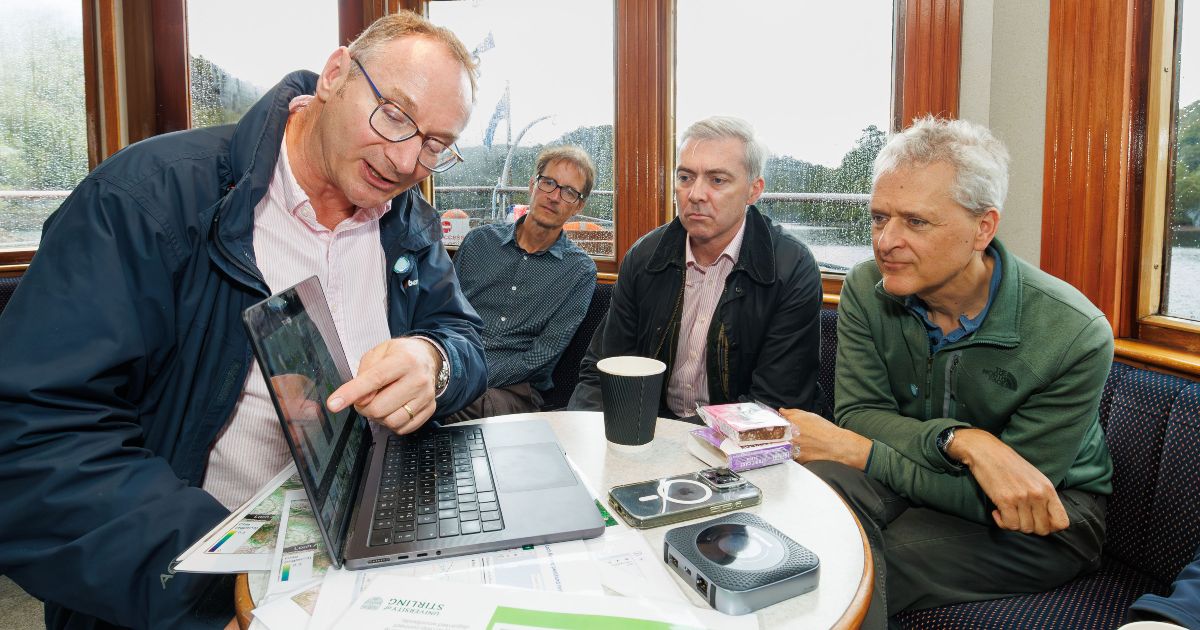Pioneering environmental sensors installed on Scotland’s oldest steamship
Sensors have been installed on the Sir Walter Scott that are transforming Scotland’s ability to monitor and respond to changes in the environment.
/filters:format(webp)/filters:no_upscale()/prod01/cdn/media/stirling/news/news-centre/2025/sep-25/1200X630Forth-ERA-(1).jpg)
State-of-the-art-sensors have been installed on Scotland’s oldest steamship to support the monitoring of water quality and impacts of climate change.
The sensors onboard the Sir Walter Scott steamship, on Loch Katrine in the Trossachs, form part of the Forth Environmental Resilience Array (Forth-ERA) - a first of its kind digital observatory of the Firth of Forth's entire water catchment - allowing researchers to collect real-time data on water quality.
The groundbreaking Forth-ERA system - built by the University of Stirling - was demonstrated to a delegation of scientists and policymakers, who visited Loch Katrine to see first-hand how the new approach is transforming Scotland’s ability to monitor and respond to changes in the environment.
Data on surface water from Loch Katrine is combined with satellite data, together with data on peatlands, tree coverage and air quality, to present a rich picture of the region’s environmental health. The catchment scale ‘living laboratory’ powered by more than 1,000 sensors provides vital, real-time information on water quality and quantity, enabling businesses, policymakers and conservationists to trial new, lower carbon ways of working and mitigating climate extremes, including floods and droughts, by modelling and assessing their environmental impact.
Rich real-time data
Professor Andrew Tyler, Scotland Hydro Nation Chair at the University of Stirling, said: “The Forth Environmental Resilience Array is transforming how Scotland’s environment is managed. By collecting rich, real-time environmental data at catchment scale and collaborating with core stakeholders in industry and government, researchers at the University of Stirling are transforming the Forth catchment into a global exemplar for environmental monitoring.
“Our pioneering approach can be further developed and scaled, providing a host of organisations with the data and insights to necessary to trial and introduce new products and services that help Scotland lead the world in adapting to climate change.”
Among the visiting delegation were representatives from Scotland’s environmental sector, including Scottish Water, SEPA, and NatureScot, together with Professor Mat Williams, Scottish Government’s Chief Scientific Adviser for Environment, Natural Resources and Agriculture.
 Professor Andrew Tyler showcases the system to Professor Mathew Williams onboard the Sir Walter Scott
Professor Andrew Tyler showcases the system to Professor Mathew Williams onboard the Sir Walter Scott
Professor Mathew Williams, the Scottish Government’s Chief Scientific Adviser for Environment, Natural Resources and Agriculture, said: “The Forth-ERA initiative exemplifies how the integration of advanced sensing technologies and cross-sector collaboration can significantly enhance our capacity to monitor, model, and respond to the multifaceted impacts of climate change.
“By generating high-resolution, real-time environmental data across a catchment scale, the project provides a robust evidence base to inform adaptive management strategies and support the transition toward a more resilient and sustainable socio-ecological system.”
Elise Cartmell, General Manager Zero Emissions at Scottish Water, said: “The work that is being done as part of the Forth-ERA project will provide us with vital information and data about how the water quality across this catchment is changing in the face of climate change and how our measures to support more resilient catchments are working.
“This includes a range of work including peatland restoration and woodland creation at Loch Katrine to help protect the water quality in this area – we need to collate the evidence to show how effective this work has been which is what this research will allow us to do.”
Flagship project
Forth-ERA is a flagship project led by Scotland’s International Environment Centre (SIEC). SIEC is supported by £5m in funding from the UK Government and £17m from the Scottish Government through the Stirling and Clackmannanshire City Region Deal.
The Stirling and Clackmannanshire City Region Deal is a £90.2m investment from the UK Government and Scottish Government in innovation and infrastructure that will drive inclusive economic growth throughout the region. Regional partners, including Clackmannanshire Council, Stirling Council, and the University of Stirling, will invest up to £123.8m, resulting in a Deal worth more than £214m.
The visit to Loch Katrine was led by the Scotland Hydro Nation Chair - a research and innovation programme hosted by the University of Stirling and funded by Scottish Water - that brings Scotland’s water sector together to deliver sustainable water management, supporting the drive towards Net Zero.
